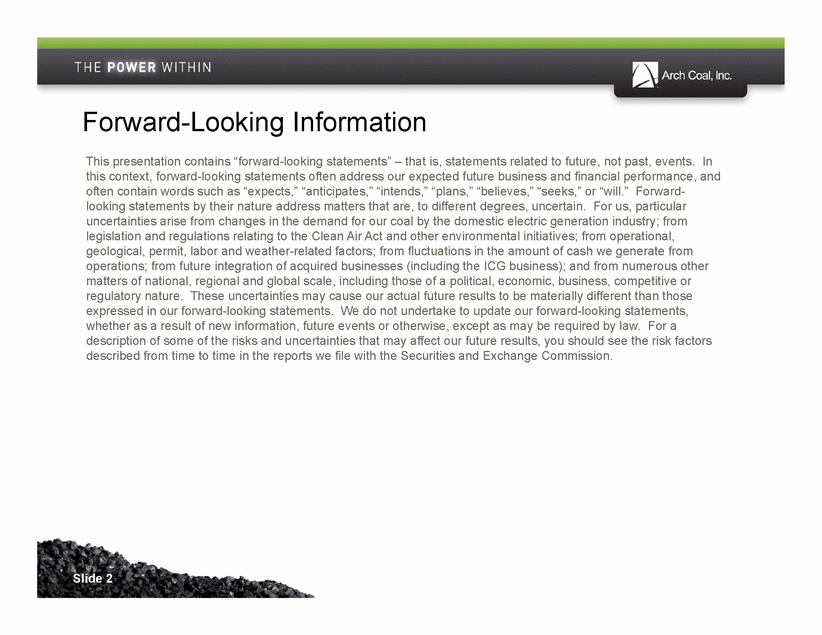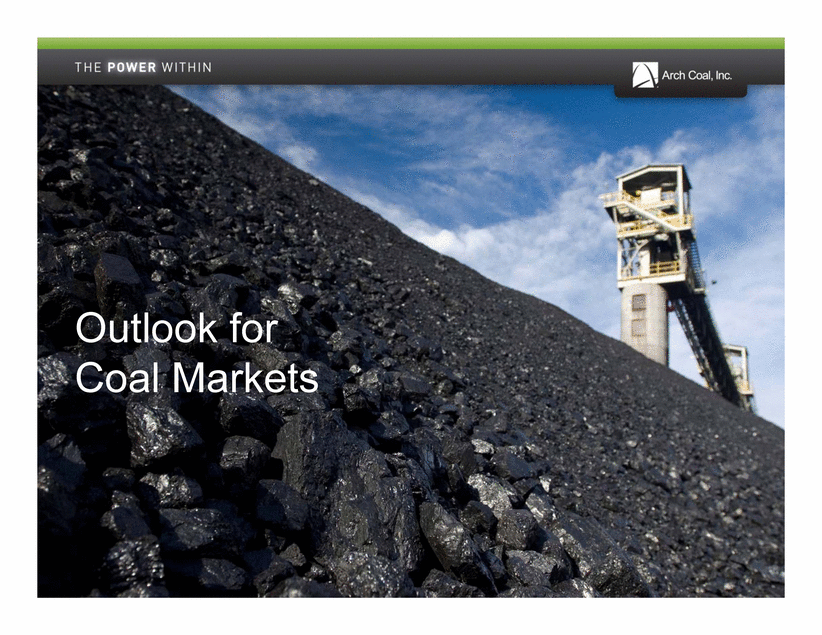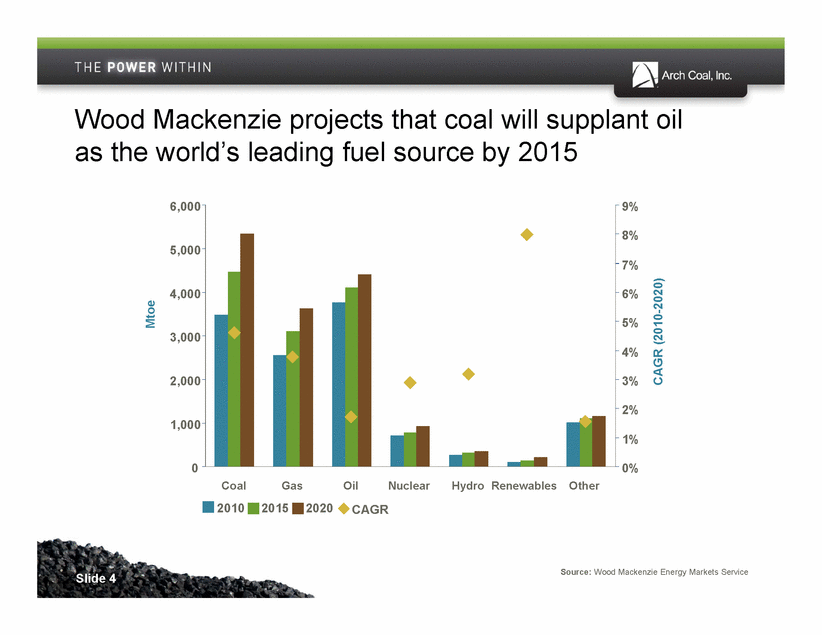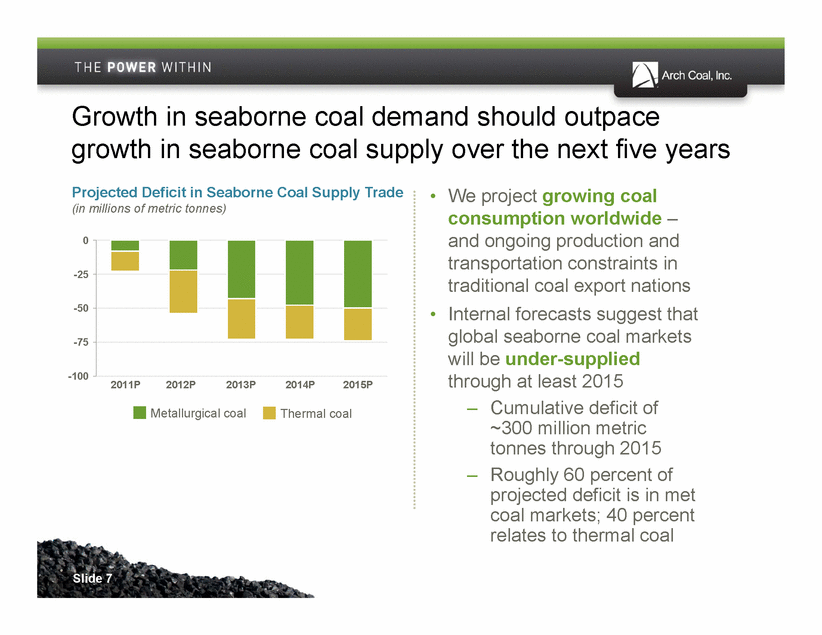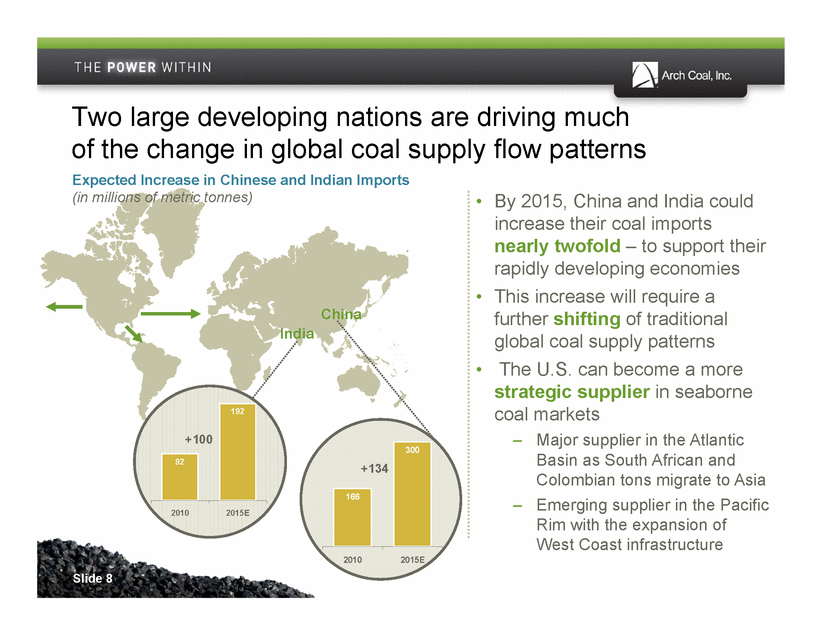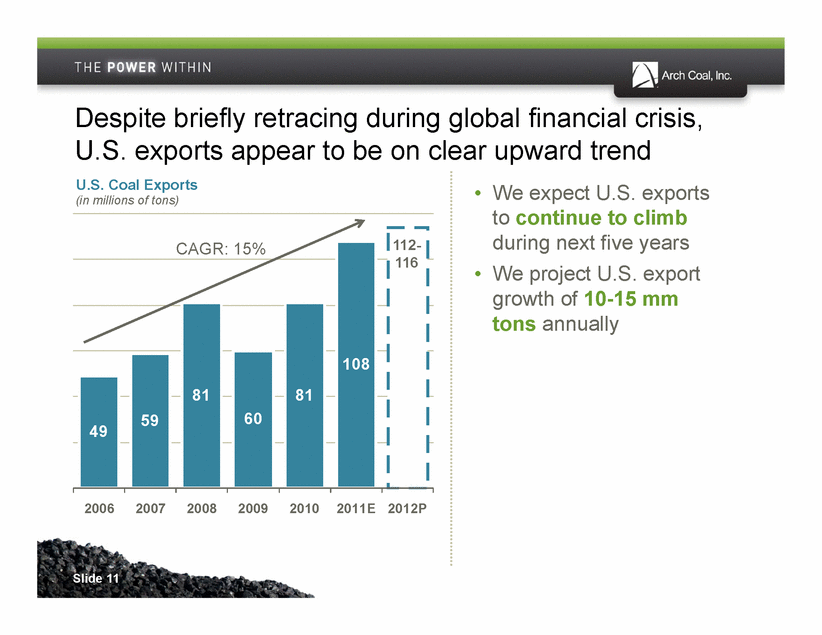Exhibit 99.1
| Is America’s Role as a Swing Supplier a Thing of the Past? JOHN EAVES President & COO Arch Coal, Inc. Miami | 2.2.2012 |
| Slide 2 This presentation contains “forward-looking statements” – that is, statements related to future, not past, events. In this context, forward-looking statements often address our expected future business and financial performance, and often contain words such as “expects,” “anticipates,” “intends,” “plans,” “believes,” “seeks,” or “will.” Forward-looking statements by their nature address matters that are, to different degrees, uncertain. For us, particular uncertainties arise from changes in the demand for our coal by the domestic electric generation industry; from legislation and regulations relating to the Clean Air Act and other environmental initiatives; from operational, geological, permit, labor and weather-related factors; from fluctuations in the amount of cash we generate from operations; from future integration of acquired businesses (including the ICG business); and from numerous other matters of national, regional and global scale, including those of a political, economic, business, competitive or regulatory nature. These uncertainties may cause our actual future results to be materially different than those expressed in our forward-looking statements. We do not undertake to update our forward-looking statements, whether as a result of new information, future events or otherwise, except as may be required by law. For a description of some of the risks and uncertainties that may affect our future results, you should see the risk factors described from time to time in the reports we file with the Securities and Exchange Commission. Forward-Looking Information |
| Outlook for Coal Markets |
| Wood Mackenzie projects that coal will supplant oil as the world’s leading fuel source by 2015 Slide 4 0 1,000 2,000 3,000 4,000 5,000 6,000 Coal Gas Oil Nuclear Hydro Renewables Other Mtoe 0% 1% 2% 3% 4% 5% 6% 7% 8% 9% CAGR (2010-2020) 2010 2015 2020 CAGR Source: Wood Mackenzie Energy Markets Service |
| We expect continued strength in met coal markets – based on projected growth in steel consumption globally Slide 5 10 4 2 15 29 15 Total Growth in World Steel Consumption (in billions of tonnes of finished steel) 0.0 0.5 1.0 1.5 2.0 2000 2005 2010 2011P 2012P 2014P 2020P Iron & Steel Capacity Build Out* Through 2015 (in millions of tonnes of raw steel, blast & basic oxygen furnaces) Sources: ACI, World Steel Association and Steel Business Briefing *Excludes electric arc furnace capacity • Growth in world steel consumption is projected to increase nearly 60 percent during the next decade • Met coal demand growth will come from increased utilization at existing steel plants along with a build out of new steel capacity – Asia-Pacific market is leading the steel capacity build out – Robust growth is also projected in Atlantic Basin market (Brazil, Eastern Europe) |
| 425 GW 1.4 billion tons Africa Europe Nations around the world are building coal plants to fuel electricity needs 425 GW of total coal-fueled capacity is planned to be online by 2015... and will be fueled by 1.4 billion tons of coal New Coal-Fueled Generation Coming Online by 2015 United States Middle East Latin America CIS countries China Other Asia India 17 6 2 8 5 97 27 83 4 (Capacity under construction, in GW, from 2011-2015) Sources: ACI and Platts International, estimates based on plants currently under construction or planned Under Construction 249 GW 790 million tons Total Slide 6 |
| -100 -75 -50 -25 0 Growth in seaborne coal demand should outpace growth in seaborne coal supply over the next five years Projected Deficit in Seaborne Coal Supply Trade (in millions of metric tonnes) 2011P 2012P 2013P 2014P 2015P Slide 7 • We project growing coal consumption worldwide – and ongoing production and transportation constraints in traditional coal export nations • Internal forecasts suggest that global seaborne coal markets will be under-supplied through at least 2015 – Cumulative deficit of ~300 million metric tonnes through 2015 – Roughly 60 percent of projected deficit is in met coal markets; 40 percent relates to thermal coal Metallurgical coal Thermal coal |
| 192 92 2010 2015E Two large developing nations are driving much of the change in global coal supply flow patterns 166 300 2010 2015E +100 +134 Expected Increase in Chinese and Indian Imports (in millions of metric tonnes) • By 2015, China and India could increase their coal imports nearly twofold – to support their rapidly developing economies • This increase will require a further shifting of traditional global coal supply patterns • The U.S. can become a more strategic supplier in seaborne coal markets – Major supplier in the Atlantic Basin as South African and Colombian tons migrate to Asia – Emerging supplier in the Pacific Rim with the expansion of West Coast infrastructure China India Slide 8 |
| Traditional supply sources are struggling to keep pace with demand, making U.S. coal increasingly competitive Slide 9 • Depleting own reserves at unprecedented (and accelerating) rate • Production is migrating further from population centers • Imported coal often offers significant quality and environmental advantages China Australia • New reserve areas have higher costs – and greater infrastructure needs • Demand continuously runs ahead of investment • Government, regulatory and community impediments are on rise Indonesia • Coal quality is declining and infrastructure is a huge challenge • Capital required to open new reserve areas is substantial • Growing domestic demand could ultimately constrain export growth • India faces quality, land use, environmental and infrastructure challenges • South Africa is increasingly mature and infrastructure needs are great • Russia faces reserve depletion in West and infrastructure needs in East • Mongolia and Mozambique have coal but no roads, rail, ports or miners Other Supply Regions Supply pressures |
| We expect exports from nearly every major supply region to grow significantly over the next two decades Slide 10 Source: Wood Mackenzie Energy Markets Service 0 500 1,000 1,500 2,000 2,500 2011 2013 2015 2017 2019 2021 2023 2025 2027 2029 Australia Colombia Indonesia Russia South Africa USA Major Coal Supply Regions (in millions of tons) |
| Despite briefly retracing during global financial crisis, U.S. exports appear to be on clear upward trend U.S. Coal Exports Slide 11 • We expect U.S. exports to continue to climb during next five years • We project U.S. export growth of 10-15 mm tons annually 49 59 81 60 81 108 2006 2007 2008 2009 2010 2011E 2012P (in millions of tons) 112- 116 CAGR: 15% |
| Australia U.S. Canada Mongolia Russia • The U.S. is already an essential source of seaborne metallurgical coal – second only to Australia • U.S. output of low-vol and mid-vol coals is comparable to that of Canada Sources: Wood-Mac and ACI The U.S. already plays a sizable and increasingly essential role in global met markets 2011 Metallurgical Export Coal Supply (in millions of tonnes) 147 64 27 23 17 Low-Vol Mid-Vol High-Vol Slide 12 |
| Planned U.S. port expansions could support a more than doubling of coal exports by 2015 East Coast Capacity Port 2015P Lamberts 32 DTA 22 Pier IX 14 CNX Marine 16 Chesap. Bay 6 Other East 8 East Coast 98 West Coast Capacity Port 2015P Ridley** 5 Westshore** 5 MBT 15 SSA Marine 15 CA/Other 5 West Coast 45 Gulf Capacity Port 2015P Port 2015P IMT 14 United Bulk 10 Burnside 10 IC Marine 8 Gulf 42 Mid-streaming 18 Midwest Capacity Port 2015P Great Lakes 10 Southern Capacity Port 2015P Mobile 18 Charleston 9 Texas 5 Southern 32 2011E* 2015P 108 million tons 245 million tons Sources: ACI, Goldman Sachs Research, NMA, Port Terminal Presentations * Includes overland shipments to Canada/Mexico 2010A* 81 million tons Slide 13 Projected Export Capacity ** Capacity available for U.S. sourced volumes |
| We expect U.S. coal to play an increasingly important role in the Pacific Basin in the coming decade Source: Wood Mackenzie Energy Market Service Slide 14 • Approximately 10 million tons of coal moved off the West Coast into Asia in 2011 • Most of that tonnage moved through Canada, but plans are underway to add U.S. throughput capacity • We expect West Coast exports to grow significantly over the next five years • Two major port projects – and several smaller ones – are in the permitting process • We believe the appetite for U.S. coal in Asia is immense U.S West Coast Port Potential Gray’s Harbor Cherry Point Longview Coos Bay Port of St. Helens Ridley Island Port of Morrow |
| Slide 15 The New Arch Coal |
| 246 122 97 64 179 BTU ACI ANR CLD CNX 248 246 179 122 431 Coal India Shenhua BTU ACI ANR 4.4 1.8 5.0 5.5 7.8 BTU ACI ANR CNX PCX Sources: ACI, Ventyx, Company filings * Pro forma 2010 Top Five U.S. Coal Producers (in millions of tons) Top Five Global Coal Producers (in millions of tons) Top Five U.S. Reserve Holders (in billions of tons) * * * * * * #2 #2 #4 Slide 16 Arch is one of the largest coal producers in the U.S. and the world |
| Western Bituminous Southern Powder River Basin Illinois Basin Appalachia 1,353 million 1,905 million 455 million 653 million 431 million 736 million 5.5-Billion-Ton Reserve Base (pro forma reserves at 12/31/10) Thermal reserves Met/PCI reserves Northern Powder River Basin Slide 17 • Operations now extend to every major coal-supply basin • Control a robust U.S. product slate, with representation in all major segments Arch is the most diversified U.S. coal producer, and the No. 2 reserve holder in the nation |
| 0.0 3.0 6.0 9.0 12.0 15.0 2010 By 2014 By 2015 ACI Expected Metallurgical Coal Volumes (in millions of tons) Our “15 by ’15” plan – to grow met volumes to at least 15 million tons by 2015 – is well underway Tygart Valley #2, #3 Slide 18 • Accelerated development of Tygart Valley (longwall production now expected in mid-2013) will add 3.5 million tons to our met production profile • Upgrades to Beckley and Sentinel preparation plants will increase efficiencies and yield of higher-quality met coal • Increased PCI sales from the expanded Lone Mountain complex |
| Expected Metallurgical Quality in 2017 Slide 19 Arch is building a world-class, high-vol “A” mining complex on former ICG reserves Total met output should reach 19 million tons by 2017 – with over 50% of that total higher-quality coals Shelby Run Tucker Run Tygart Valley Rosemont Sentinel (operating) Tygart No. 3 10% PCI 10% 35% High Vol “B” 35% 20% Low Vol 10% High Vol “A” 45% 19 MT |
| East Coast Gulf Coast (New Orleans) West Coast • Own 22% interest in DTA in Newport News, VA which has throughput capacity of ~20 million tpy • In final discussions with Kinder Morgan for port space at KMP-owned facilities on East Coast • Ownership and throughput rights at river facilities in Kentucky and Illinois • Long-term throughput agreement with Kinder Morgan that supports expansion of Gulf Coast export facilities • Own 38% interest in Millennium Bulk Terminals in Washington state • Agreement with Ridley Terminals in Canada • Commitments to move Western Bituminous coals through ports in California Arch will play a growing role in the global seaborne met and thermal coal trade Slide 20 |
| Is America’s Role as a Swing Supplier a Thing of the Past? JOHN EAVES President & COO Arch Coal, Inc. Miami | 2.2.2012 |

